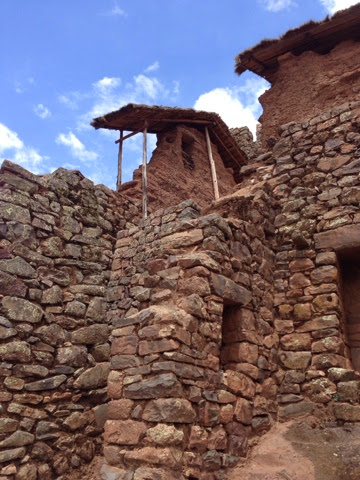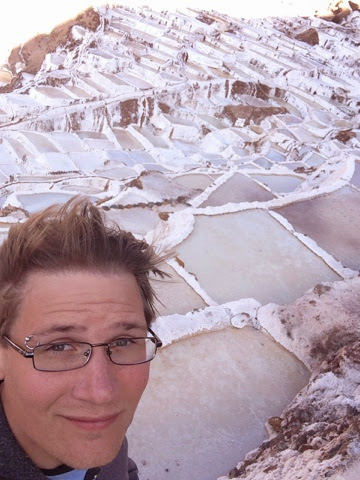Well Machu Picchu is obviously the big deal in Peru. People come from all over the world to see this fairly marvelous city - perched on a small plateau between mountains that climb straight up and are covered in thick vegetation.
On the way to the place I was trying to figure out what is so impressive about this place as opposed to some of the other spots in the area (like the ones in the Sacred Valley).
So what is this Sacred Valley you ask? (Thanks for asking, it would have been weird to answer if you hadn't asked).
The Sacred Valley is a stretch of really lovely farm land between the mountains north of Cusco. The land originally belonged to some neighbors of the Tawantinsuyo but during their expansion phase either by force or alliance they incorporated these rich lands and began to terrace them heavily. They built great estates and mountain fortresses and did a bunch of cool things that are still around today.
But wait Mike you said farms and fortresses, what's so sacred?
Well that is a good question dear reader, I'm glad you are keeping up with my random thought patterns.
The Sacred Valley isn't sacred in the way you and I know the word sacred to mean, it's sacred because these valuable farmlands and towns were privately owned by the Incas (the emperors and their families, as well as their cults). So why does that mean sacred? Well because the Incas were the sons of the Sun -the principle/second best god in the Inca pantheon. Second best because of course the sun was created by the Great Creator who all Andean peoples know, but the Inca's patron god was the sun god Inti. The biggest and best temples were always devoted to the sun.
Ok we are getting off track. Let's go back to the Sacred Valley. As the Incas took the land, they continued to become more wealthy (wealth at the time was food). As they acquired more food, they of course could afford to have bigger armies and bigger armies intimidate people into joining your alliance.
So the Incas got rich and their empire expanded and as it did, they also incorporated the technologies and specialties of other regions. Military techniques, ceramic techniques, aqueduct techniques, building techniques and of course the all important agriculture!
A long time ago people estimated that the Andean civilizations and really the whole of the Americas couldn't have supported more than a few million people. Recent estimates based on the agricultural yields possible based on things like the Incan practices suggest 10s of millions if not hundreds of millions of people. Suddenly it starts to make sense how you can build a massive city or 5 within a few years, or conquer the entire Andes mountain region.
So what are we talking about cities and agriculture. Well most of the original buildings in Cusco were taken apart to make churches. Here is an example:
Pictures above is a big monasterial complex including churches and chapels and places where monks used to live, and places where they still live. BUT the entire thing is built on top of the holiest temple of the Tawantinsuyo. You can still see walls from the original underneath (they are the better ones).
The ruins outside of Cusco were also used as a quarry, but if you go to the town of Pisaq, up the hills (an expensive taxi ride up the hill to be exact) is this:
The old city of Pisaq had several different neighborhoods, a massive cemetery, lush agriculture terraces, and a mighty fortress. It may not be as pretty as Machu Picchu but it's quite impressive.
So let's talk terraces y'all.
Terracing in the highlands is how they got so much food. These are not the cuts into the hillside that the people make today, many of the terraces were built up from the hillside, stone enclosures, filled with layers of small rocks, clay, rough dirt and rich soil. They controlled for water run off, and allowed the people to grow different types of crops at different levels. They understood the elevation so well that at Moray (pictured below) it's estimated each level of the terrace had a different temperature. Moray is believed to be an agriculture testing ground. An agriculture university lab, where crops were grown and manipulated to get the highest yields at different elevations.
Can you believe this stuff?
Another thing you notice in the Sacred Valley is that there are terraces everywhere! Many are still being used, others have gone by the wayside, but it's crazy to look up in the mountains (regardless of height) and recognize the familiar steps.
This picture is back at Pisaq, but this should demonstrate the height of these things. In most cases they are about the height of a person give or take a foot. Some are clearly much bigger - so many have steps built into the side.
Ok so the Sacred Valley has some cool old ruins and lots of terraces, big deal yeah? Well I suppose for the most part that is true. Today the Sacred Valley is primarily a series of small towns and farms. The people live like most others in the area, a mix of older traditional ways and newer ways.
Here are some shots from the biggest city in the Sacred Valley Urubamba:
Most people in the sacred valley are just going about their business. The tourism tends to be concentrated in areas where buses can park and let out hordes of camera clicking tourists... Which is mainly at the craft stores, tourist restaurants and look out points outside of the towns.
One of these tourist spots is at the local salt ponds, near the small town of Maras. This is an actively used series of salt beds, that allow tourists to take fun pictures and buy salty goods. But it's important to note that people have been doing this at this location for hundreds of years... Well before Mike and his camera showed up.
One of the last cities before Machu Picchu is also considered one of the most traditional. The city of Ollantaytambo (which is hard to pronounce oye-yen-tay-tam-bo, depending on accent) was one of the last fortresses used to prevent Spanish invasion of Machu Picchu and other settlements beyond the valley. The cliffs narrow in the area and the Inca changed the course of the river, along with making some other fortifications to withstand any invasions. Parts of the city are quite touristy (the main square, the area near some of the ruins, the area near the trains) but the city on the whole is still considered a good example of Inca style city design, and many of the buildings and people maintain traditional ways.
Ollentaytambo is extremely impressive. The amount of stone work, the terraces that surround the whole area, the tombs high in the mountain, the storehouses, the massive stone blocks, perfectly cut and fitted into place.
For many travelers to Machu Picchu Ollentaytambo is like the warm up to the big show, but the site is so impressive in itself it's surprising to me it isn't more famous.
Also there is a kwik e mart in town.
Ok so what's this Machu Picchu all about?
Well I suggest you read a real article I you really want to know something, but here's some quick info about the whole deal.
Facts:
1) Machu Picchu isn't that old. It's less than 600 years old, and wasn't finished because the residents decided it was better to flee into the jungle and start over rather than face the oncoming Spanish. Tactically this makes no sense to me as they clearly had the advantage, but perhaps diseases and fear devastated the psyche of the people enough that they would rather face the buzz of the jungle.
2) Machu Picchu is located in the cloud forests, which is the geographic area between the highlands and the jungle. This means it has a tropical (green) and warm feeling even though you are ~2500 meters high.
3) It's a pretty remote place. There are numerous ways to get to MP, but in the end you are almost always walking up through either the main gate or taking the Inca Trail and walking up through the Sun Gate. Or you pay 10$ like the majority of us and get dropped off at the main entry.
All folks going to the main entrance started in Machu Picchu pueblo otherwise known as Aguas Caliente, one of the most touristy towns on earth. There are various ways to get to this small town, but the general consensus is that once you are there you would rather not be.
Basically every street is lined with services for tourists (food, souvenirs, travel stuff, hotels). The town has a reputation for being kind of shady -as in every single time money is exchanged they will try to rip you off (hidden fees, miscalculations, up charging). It's kind of a raucous town by night time, but during the day the streets are basically empty because everyone is at Machu Picchu.
There are a number of cool attractions that 99% of oeople including myself skipped. Prices for hotels and hostels are fairly cheap, but food and other stuff can be double or triple the normal amount.
Consider the amount for the 25 minute bus ride to Machu Picchu -$10. No big deal right? But then consider a collectivo (mini bus) through the entire Sacred Valley (several hours if you go straight through) costs between $3-5.
One of the most popular scams (literally every restaurant) is the "happy hour" price of 4 beers for 1. Pretty great deal until you find out one beer costs 7-8$ normal price around here would be 2-3. Still not a bad deal, just takes most people by surprise when they thought they were getting a deal and end up paying the normal amount. These scams work out fine, because most people are only in Aguas Caliente for a night.
But I digress... What were we talking about again? Tortugas Ninja... No that's not right.
Oh yes Machu Picchu...
Ok well there's really not a lot to say... It takes your breath away, literally if you climb up the mountain.
I'd suggest climbing one of the mountains at least... I mean how else can you get these great views.
No but seriously the view from the mountain is great if you want to see the surrounding area and are willing to wait until the clouds clear up(10-11 am).
As you can tell, it's pretty far away from Machu Picchu, I had no idea what I was getting into... I thought the mountain was one of those little guys down there.... Turns out Huayna Picchu (the small mountain behind the city, is roughly at the same height as the Sun Gate which I did as a warm up to Machu Picchu mountain (till around 7:10 am).
Anyway so the mountain is high up. The first few hours of my time was spent looking through clouds and trying not to get depressed about the ridiculous amount of steps in front of me...
Well I hung out all day with some hilarious Europeans and had a great time.
We took a tour in the afternoon and learned about the city. Here are some pictures of the place.
I won't bore you with the details but let's just say by the end of the day I was TIRED...
Oh I should also mention on a serious note be very careful at Machu Picchu or you can catch the dancing fever (potentially deadly if you don't watch your step).








































Note the agricultural terraces ate in the shape of a uterus
ReplyDelete